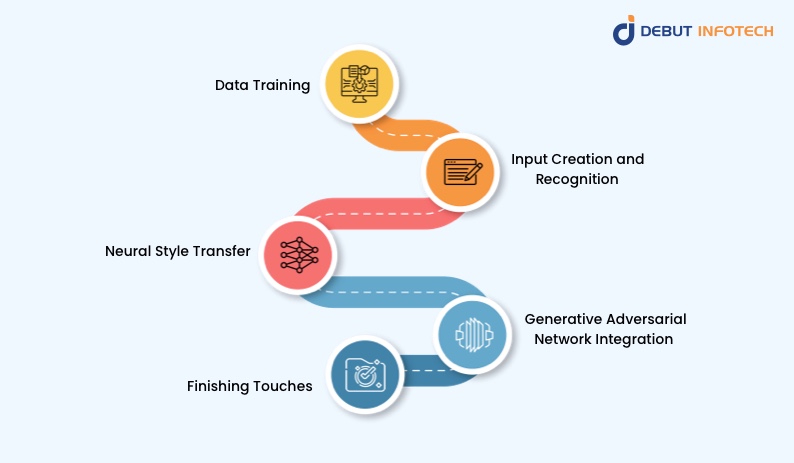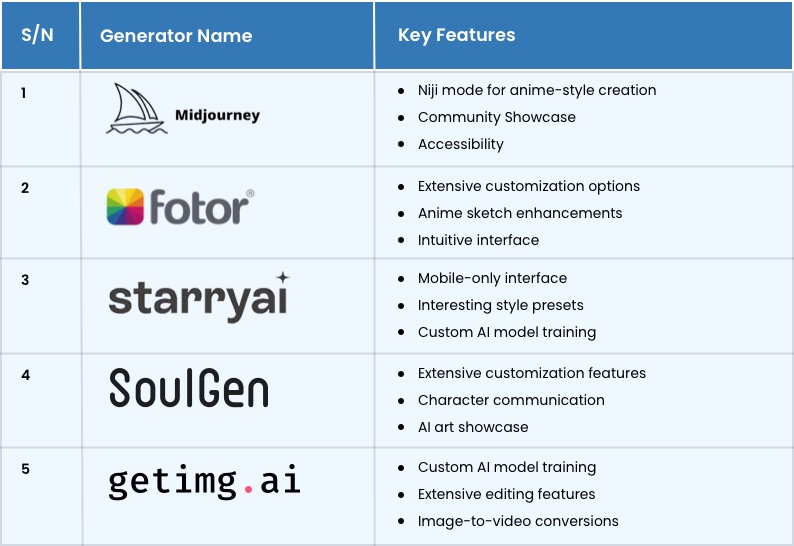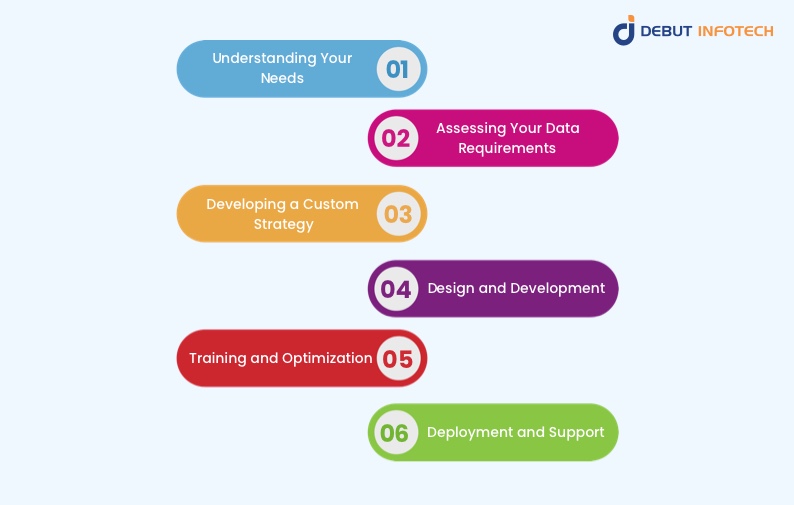Table of Contents
Home / Blog / AI/ML
A Guide to AI Generated Anime Art Software Development
January 28, 2025

January 28, 2025
Creating anime art is tedious. According to Naruto creator Masashi Kishimoto, “it is seriously tough in terms of stamina.” This is because the process involves many steps, such as creating a storyboard and drawing the linework.
However, as AI technology continues to evolve, we’re seeing it relieve some of the workload on manga artists and anime creators by helping with AI-generated anime art.
In this article, we examine the entire concept of AI generated anime art by discussing what they are, how they work, and the top examples of anime AI art generators available for use online today. Finally, we discuss Debut Infotech’s approach to building one of these anime AI art generators.
Let’s get straight into it.
What is AI Generated Anime Art?
AI generated anime art is an emerging art form that uses AI and machine learning tools to create the popular Japanese animation style known as Anime.
Creating anime is extremely time-consuming. This unique art form involves intricate writing, storyboarding, character design & development, animation, voicing, color design, and style transfer. It takes a lot of time and effort to bring these captivating anime characters and art forms to life, and anime artists do it either using traditional 2D techniques or digital 3D animation software, but these processes take a lot of time and effort.
However, with AI-generated anime art, the artist only needs to come up with an idea for the anime art form they wish to create, summarize this idea in a written prompt, and pop it into the AI anime art generator, and Voila! There’ll be an anime art in a few seconds or minutes, depending on the tool.
Of course, anime artists don’t always have to create the entire aspects of the anime with the AI generator. They can always also generate ideas or automate inconsequential routine aspects of this creation process with the AI generator. However, the key point here is that AI generated anime art is any anime art form that is created with the help of AI tools.
How Does Anime Art AI Generated Software Development Work?

AI and machine learning tools function similarly across different industries. They often have similar goals, too: to accelerate the creative process.
When it comes to the creation of anime art, AI generators focus on creating new, exciting AI art by mimicking the human creative process of other anime artists. The entire process of generating AI-generated anime art can be summarized into the following steps:
1. Data Training
The first step in creating AI-generated anime art is calibrating the AI model with vast datasets of anime art. These tools use algorithms and machine learning models to analyze thousands of previously created anime art and gradually devise a better, or at least new, way of creating something new.
Machine learning models are able to do this because they are made of neural networks that allow them to recognize patterns and solve common problems just like the human brain does. The data training process helps the AI model learn the distinctive style and features of this anime art. After sufficient training, the model learns how to create anime art that resembles the ones it was trained with.
2. Input Creation and Recognition
Now that we have a sufficiently trained AI model, creators can jump straight into the creative process by imputing texts or image prompts into the model. These prompts, sketches, text descriptions, and live images guide the model on how to create anime art by detecting facial features and aligning them with previous knowledge.
3. Neural Style Transfer
AI art generators are usually equipped with style transfer models whose job is to produce distinct anime art by literally transferring the patterns and styles recognized earlier to the text or image prompt imputed now. We’re talking about color schemes, shading, and line art.
4. Generative Adversarial Network Integration
Different kinds of AI models are used to generate anime art. Generative Adversarial Networks are a prominent example. These AI models involve a pair of neural networks—a generator and discriminator—both of which iteratively train themselves to create realistic images and identify fake ones, respectively.
5. Finishing Touches
After the initial creation process, the creator finetunes the final output by applying filters, denoising the algorithm, and adjusting the brightness and color saturation to ensure a coherent final result.
The application of AI algorithms to the anime art creation process takes a heavy workload off the shoulders of anime artists so that they can focus on more creative aspects of production. And it’s been great so far.
For example, with the help of generative AI, creators are reducing the time it takes to create in-between animation frames from about 2 – 3 weeks to 4 – 5 hours with the use of AI. AI also helps to convert real movements into animated ones. Furthermore, background coloring, that normally takes about a week when done manually, can be reduced to about 5 minutes with the help of AI.
Discover the Benefits of AI Solutions to Your Anime Art Creation Process
Augmenting your anime art creation process with advanced AI models can increase your productivity.
Top Examples of Anime AI Art Generators Online
The table below summarizes some key details about the top examples of AI generated anime art generators you can use to create your anime art.

1. Midjourney
After being launched in 2021 by David Holz in San Francisco, Midjourney has quickly become one of the most reliable tools for generating AI images. More specifically, when users switch to its Niji creation mode, Midjourney helps them create anime art.
The platform uses an innovative text-to-image generator that requires users to simply pop a prompt describing the idea of anime art they have in mind and receive stunning images depicting those ideas. The more exciting aspect of this is that creators can either do this via Midjourney’s website or its Discord interface. This gives users a lot of flexibility, and as a result, over 13 million discord members are currently using the platform. When it comes to anime art generation, Midjourney is an excellent option for both beginners and seasoned enthusiasts because of its ease of use and stunning results.
Key Features
- Accessibility: Midjourney is available both as a website and a Discord bot.
- Community Showcase: Midjourney allows creators to tap into the creativity pool of other community members (which are over 13 million) by seeing their anime art and gaining inspiration from them.
- Prompting: The Midjourney bot allows users to input short text phrases, which it interprets and uses to generate an image.
2. Fotor
Fotor is an awesome AI art generator that focuses on turning text and image prompts into visually stunning digital art pieces. It is highly versatile for creating different types of art pieces, ranging from realistic drawings and digital art to anime paintings.
Unlike Midjourney, which has a Discord interface in addition to the website, Fotor majorly has a web-based interface for art generation. As such, it is easily accessible from anywhere. In addition, the platform offers over 100 stable diffusion-based models to help different categories of anime artists create their preferred types of anime art. More so, it has gained a major reputation for turning ordinary images into captivating anime art.
Key Features
- Anime Sketch Enhancements: With Fotor, users can upload their rough anime sketches and get complete and refined anime art.
- Extensive Customization Options: The platform has a lot of customization, editing, and enhancement features to make the anime art as close to your imagination as possible.
- User-friendliness: Fotor’s interface is equipped with advanced AI tools that ensure that users put in only a minimal effort when creating their desired anime art.
3. StarryAI
With three separate AI models—Argo, Altair, and Orion—on the StarryAI platform, users can now create their preferred category of AI art by just inputting a text prompt describing their idea. StarryAI provides an avenue for creating different artistic styles and outputs for both casual creators and seasoned anime artists.
It offers numerous anime styles such as Anime, Animagine, Semi Realistic Anime, Full Body Character Creator, Manga Sketch Art, Character OC Creator, Character Sheet Sketch, etc. These interesting style presets allow new anime art creators to create exciting anime art in the styles of established creators like Tim Burton, Comic Books, and Art Deco. However, it also allows creators to develop their own creative styles by uploading between 5 and 16 images or gaining inspiration from the thousands of styles created by other users on the platform.
Modern-day creators who particularly love to create on the go will definitely love StarryAI because it comes in a mobile-only app. This app is clean, intuitive, and powered by a powerful AI engine capable of generating anime art in a breeze.
Key Features
- Exciting Style Presets: It functions like a pre-trained AI model by offering different examples of anime art creations that mimic the styles of established artists.
- Mobile-first Approach: The mobile app is perfect for on-the-go art creation.
- Custom Training: StarryAI allows users to train its AI models with their images to create unique styles.
4. Soulgen
Soulgen is one of the most effective AI generator tools for creating hyper-realistic anime characters. The tool interprets and creates anime characters by meticulously examining minute details in text prompts. Users can describe what they want to see in their anime characters in great detail, and Soulgen handles the rest.
Users can also customize the final result by selecting between different forms of anime art, such as Real Girl or Anime Girl, and Real Anime or Classic Anime. These customizations impart the final result in different ways to fit different contexts based on the creator’s imagination and preferred applications.
Additionally, Soulgen doesn’t just allow users to create anime characters. It also helps them communicate with their characters via a chat feature called Soul Chat.
Key Features
- Extensive Customization Features: Soulgen.ai offers numerous customization features to ensure that the anime characters created appear as real as possible.
- Character Communication: Soulgen.ai’s Soul Chat feature allows creators to chat with the anime characters they create.
- AI Art Showcase: The Soulgen.ai platform has an extensive library of AI-created anime art, which can inspire new anime art ideas.
5. Getimg.ai
Getimg.ai is a well-rounded anime art creation platform for creators due to its text-to-image, image-to-image, and Dream Booth feature sets. The platform uses a staggering 15 powerful ControlNet pipelines for generating anime-style images, resulting in 60+ community-trained models in various styles and advanced settings. In addition to that, it also allows users to custom-train their AI models using their preferred images via a feature known as the Dream Booth.
These features combine to ensure the platform generates only fresh imagery and unique anime art ideas. To ensure the final product is ready for sharing, Getimg.ai also possesses a host of AI editing tools for finetuning generated images and adding finishing touches.
It guarantees the delivery of crispy quality images at all times by using modern AI models like the SDXL. As such, Getimg.ai is an ideal AI anime art generator for anime creators seeking a comprehensive and user-friendly platform.
Key Features
- Custom AI Model Training: Getimg.ai allows users to custom-train their own AI models using their preferred anime art pieces via the Dream Booth feature.
- Extensive Editing Features: The AI generator platform has extensive editing features that help creators finetune their final outputs.
- Image to Video: Getimg.ai has features that let you turn static images into 4-second anime video
How to Develop an Anime Art AI Generator: Debut Infotech’s Tailored Methodology for AI Development Solutions

Your business can also create its custom Anime Art AI generator with the right data, algorithms, and implementation systems. At Debut Infotech, we focus on an agile approach that involves the following steps:
1. Understanding Your Needs
It may sound basic, but the first step is understanding that you’re out to develop an anime AI art generator. This realization helps you understand your business objectives and technical requirements.
2. Assessing Your Data Requirements
Now that you have an idea of the kind of AI solution you want to create, you need to thoroughly analyze and assemble authentic anime datasets that’ll be used to train the AI models. These datasets must be clean, structured, and ready for effective model training. Ensuring this makes it easy for the resulting AI models to create clear and inspiring anime art.
3. Developing a Custom Strategy
Depending on the specific business segment you’re catering to, it is important to come up with a bespoke AI strategy that determines the specific AI methodologies and systems this AI generator would use. While formulating this strategy, it is important to consider specific business contexts and desired outcomes for prospective users.
4. Design and Development
After taking all business and outcome-related factors into consideration, you can then dive into designing algorithms and building models for generating anime art. At Debut Infotech, our generative AI integration services focus on creating a robust, scalable, and efficient AI generator tool.
5. Training and Optimization
Now, it is time for the developed AI models to learn from the vast datasets of anime art assembled earlier. This is an iterative process that ensures the model captures the main themes and patterns using advanced techniques.
6. Deployment and Support
Finally, the anime AI art generator can be deployed into the business environment for use. It is important to follow up after deployment to monitor performances and carry out necessary optimizations.
Amplify Your Anime Art Creation Process With Custom AI Models.
You could be creating better and more captivating animes with less time and effort with the right AI model.
Conclusion
Artificial intelligence is propelling the anime and art world forward by reducing the routine tasks in the creative process. Consequently, it is introducing more creativity into anime art creation, and with a collaborative approach that leverages the perks of human creativity and artificial intelligence, it is clear that the best is yet to come.
To get in on the action, you can reach out to generative AI development services like Debut Infotech to develop custom AI models that’ll mimic your anime sketches and ideas. This way, you get to create authentic anime art that truly mirrors your human X-factor.
Frequently Asked Questions (FAQs)
AI art generators are trained on massive datasets of existing artwork, such as paintings, sketches, and photographs. Deep learning algorithms evaluate these photos during training to learn properties such as forms, colors, and styles. This allows the AI to spot patterns and apply previously learned styles to create new graphics based on human input.
AI art producers often use large datasets acquired from many online sources, including publicly available artwork and photography. Some generators, such as Adobe Firefly, rely on licensed imagery from stock image banks to ensure commercial compliance. Others may scrape content without remuneration, causing potential copyright difficulties for consumers of the created photos.
AI-generated art can be utilized for a wide range of applications, including digital graphics, concept art, marketing materials, and social media content. It is also used to create distinctive images for video games, animations, and merchandise design.
To make anime art using AI, first enter a descriptive text prompt that defines the desired character, scene, and style. You can use AI art generators like Dreamina or Fotor, which will process your input and make images based on the parameters you’ve set. You can even further personalize the output by changing settings or adding reference pictures to improve the final artwork.
The time it takes for an AI art generator to produce results can range from a few seconds to several minutes, depending on the input prompt and the AI model’s architecture. Furthermore, demand on the platform might influence processing times, with higher traffic potentially resulting in longer wait times for users.
Talk With Our Expert
Our Latest Insights
USA
2102 Linden LN, Palatine, IL 60067
+1-703-537-5009
[email protected]
UK
Debut Infotech Pvt Ltd
7 Pound Close, Yarnton, Oxfordshire, OX51QG
+44-770-304-0079
[email protected]
Canada
Debut Infotech Pvt Ltd
326 Parkvale Drive, Kitchener, ON N2R1Y7
+1-703-537-5009
[email protected]
INDIA
Debut Infotech Pvt Ltd
C-204, Ground floor, Industrial Area Phase 8B, Mohali, PB 160055
9888402396
[email protected]




Leave a Comment